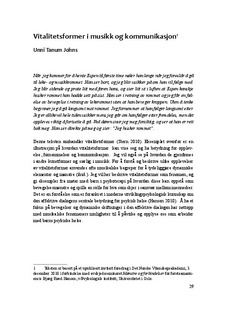| dc.contributor.author | Johns, Unni Tanum | |
| dc.date.accessioned | 2013-08-07T12:09:50Z | |
| dc.date.available | 2013-08-07T12:09:50Z | |
| dc.date.issued | 2012 | |
| dc.identifier.citation | I: Barn, musikk, helse, s. 29-43 | no_NO |
| dc.identifier.isbn | 978-82-7853-071-9 | |
| dc.identifier.issn | 1893-3580 | |
| dc.identifier.uri | http://hdl.handle.net/11250/172319 | |
| dc.description.abstract | The notion “forms of vitality” derives from Daniel Stern’s work. It was introduced early in his work as a way of describing intersubjective processes involved in the sharing of feelings, intentions, and attention. This text takes its starting point from his latest book on forms of vitality and discusses how these evolve as affective communication processes that can be better understood by the help of musical concepts. Examples are given from psychotherapy with children. These show how forms of vitality arise spontaneously in the therapeutic relationship, helps to understand the children’s feelings, needs, and intentions, and play an important role in the therapeutic work. Focusing on forms of vitality and recognizing the musical processes involved in these, is seen as an important key to children’s health. | no_NO |
| dc.language.iso | nob | no_NO |
| dc.publisher | Norges musikkhøgskole | no_NO |
| dc.relation.ispartofseries | Skriftserie fra Senter for musikk og helse;5 | |
| dc.relation.ispartofseries | NMH-publikasjoner;2012:3 | |
| dc.subject | forms of vitality | no_NO |
| dc.subject | children | no_NO |
| dc.subject | affective dialogue | no_NO |
| dc.subject | psychotherapy | no_NO |
| dc.title | Vitalitetsformer i musikk og kommunikasjon | no_NO |
| dc.title.alternative | Forms of vitality in music and communication | no_NO |
| dc.type | Chapter | no_NO |
| dc.type | Peer reviewed | no_NO |
| dc.subject.nsi | VDP::Humanities: 000::Musicology: 110::Music therapy: 113 | no_NO |
